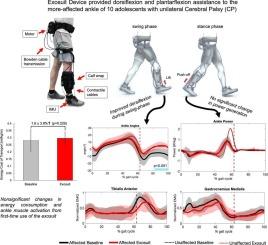踝关节外装对单侧脑瘫青少年行走的生物力学、肌肉活动和能量消耗的急性影响。
IF 1.4
3区 医学
Q4 ENGINEERING, BIOMEDICAL
引用次数: 0
摘要
背景:本研究旨在探讨一种辅助踝外服在急性增加脑瘫(CP)青少年临床相关行走参数方面的潜力。方法:10名患有单侧CP的exosuit-naïve青少年(11-16岁)在跑步机上行走,不穿外骨骼服(基线),穿着外骨骼服(ReWalk ReStore®),为他们受影响更严重的脚踝提供单侧背屈和跖屈辅助。五名参与者也使用常规矫形器行走。评估胫骨前肌和腓肠肌内侧肌的能量运输成本、运动学和动力学以及肌电图。研究结果:在摇摆阶段,外套增加了踝关节的背屈,减轻了基线行走时观察到的受影响更大的一侧的落脚。踝部峰值力矩随外骨骼的增加而增加。虽然参与者的矫形器在推离时限制了植物屈曲,但外穿服可以实现更典型的推离植物屈曲运动。穿上外套后,能量消耗和肌肉活动没有显著变化。解释:在步态过程中,外衣促进了受影响更大的腿的脚跟-脚趾踝关节的运动学,防止了落脚,同时在推蹬时保持了足底屈曲。外伤服略微增加了跖屈肌扭矩,但这并没有转化为步态中受影响更大的脚踝所增加的正能量。缺乏肌肉活动或能量消耗的变化表明,在最初使用该设备时,外骨骼辅助无法急剧改变这些参数。这些结果显示了辅助外服的潜力,可以立即增强踝关节的运动学,但也强调了外服在剧烈改变其他对持久步态变化重要的临床结果(即肌肉活动和能量消耗)方面的局限性。本文章由计算机程序翻译,如有差异,请以英文原文为准。

Acute effects of ankle exosuit on biomechanics, muscle activity, and energy cost of walking in adolescents with unilateral cerebral palsy
Background
This study aimed to investigate the potential of an assistive ankle exosuit to acutely augment clinically relevant walking parameters in adolescents with Cerebral Palsy (CP).
Methods
Ten exosuit-naïve adolescents with unilateral CP (11–16 years old) walked on a treadmill without the exosuit (baseline), and with the exosuit (ReWalk ReStore®) providing unilateral dorsiflexion and plantarflexion assistance to their more-affected ankle. Five participants also walked with their regular orthosis. Energy cost of transport, kinematics and kinetics, and electromyography of Tibialis Anterior and Gastrocnemius Medialis muscles were assessed.
Findings
The exosuit increased ankle dorsiflexion during swing-phase, alleviating drop-foot on the more-affected side observed during baseline walking. Peak ankle moment was increased with the exosuit. While participants' orthoses restricted plantarflexion during push-off, the exosuit enabled more-typical push-off plantarflexion motion. There were no significant changes in energy cost or muscle activity with the exosuit.
Interpretation
The exosuit facilitated heel-toe ankle kinematics of the more-affected leg during gait, preventing drop-foot, while preserving plantarflexion during push-off. The exosuit slightly increased plantarflexor torque, however this did not translate to increased positive power from the more-affected ankle during gait. Lack of changes in muscle activity or energy cost indicate an inability of exosuit assistance to acutely alter these parameters on initial use of the device. These results display potential of an assistive exosuit to immediately augment ankle kinematics, but also underline limitations of the exosuit to acutely alter other clinical outcomes important for lasting gait changes, namely muscle activity and energy consumption.
求助全文
通过发布文献求助,成功后即可免费获取论文全文。
去求助
来源期刊

Clinical Biomechanics
医学-工程:生物医学
CiteScore
3.30
自引率
5.60%
发文量
189
审稿时长
12.3 weeks
期刊介绍:
Clinical Biomechanics is an international multidisciplinary journal of biomechanics with a focus on medical and clinical applications of new knowledge in the field.
The science of biomechanics helps explain the causes of cell, tissue, organ and body system disorders, and supports clinicians in the diagnosis, prognosis and evaluation of treatment methods and technologies. Clinical Biomechanics aims to strengthen the links between laboratory and clinic by publishing cutting-edge biomechanics research which helps to explain the causes of injury and disease, and which provides evidence contributing to improved clinical management.
A rigorous peer review system is employed and every attempt is made to process and publish top-quality papers promptly.
Clinical Biomechanics explores all facets of body system, organ, tissue and cell biomechanics, with an emphasis on medical and clinical applications of the basic science aspects. The role of basic science is therefore recognized in a medical or clinical context. The readership of the journal closely reflects its multi-disciplinary contents, being a balance of scientists, engineers and clinicians.
The contents are in the form of research papers, brief reports, review papers and correspondence, whilst special interest issues and supplements are published from time to time.
Disciplines covered include biomechanics and mechanobiology at all scales, bioengineering and use of tissue engineering and biomaterials for clinical applications, biophysics, as well as biomechanical aspects of medical robotics, ergonomics, physical and occupational therapeutics and rehabilitation.
 求助内容:
求助内容: 应助结果提醒方式:
应助结果提醒方式:


